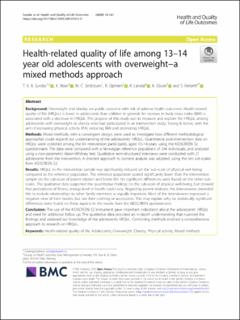Health-related quality of life among 13–14 year old adolescents with overweight−a mixed methods approach
Bigum Sundar, Turid Kristin; Riiser, Kirsti; Småstuen, Milada Cvancarova; Opheim, Randi; Løndal, Knut; Glavin, Kari; Helseth, Sølvi
Journal article, Peer reviewed
Published version
Permanent lenke
https://hdl.handle.net/11250/2756463Utgivelsesdato
2020-05-29Metadata
Vis full innførselSamlinger
Originalversjon
Health and Quality of Life Outcomes. 2020, 18, (1-10). https://doi.org/10.1186/s12955-020-01413-0Sammendrag
Background: Overweight and obesity are public concerns with risk of adverse health outcomes. Health-related quality of life (HRQoL) is lower in adolescents than children in general. An increase in body mass index (BMI) is associated with a decrease in HRQoL. The purpose of this study was to measure and explore the HRQoL among adolescents with overweight or obesity who had participated in an intervention study, Young & Active, with the aim of increasing physical activity (PA), reducing BMI and promoting HRQoL.
Methods: Mixed methods, with a convergent design, were used to investigate how different methodological approaches could expand our understanding of the adolescents’ HRQoL. Quantitative post-intervention data on HRQoL were collected among the 84 intervention participants, aged 13–14 years, using the KIDSCREEN 52 questionnaire. The data were compared with a Norwegian reference population of 244 individuals, and analysed using a non-parametric Mann-Whitney test. Qualitative semi-structured interviews were conducted with 21 adolescents from the intervention. A directed approach to content analysis was adopted, using the ten sub-scales from KIDSCREEN 52.
Results: HRQoL in the intervention sample was significantly reduced on the sub-scale of physical well-being compared to the reference population. The reference population scored significantly lower than the intervention sample on the sub-scale of parent relation and home life. No significant differences were found on the other sub- scales. The qualitative data supported the quantitative findings on the sub-scale of physical well-being, but showed that perceptions of fitness, energy level or health could vary. Regarding parent relations, the interviewees extended this to include relationships to other family members as equally important. Most of the interviewees expressed a negative view of their bodies, but not their clothing or accessories. This may explain why no statistically significant differences were found on these aspects in the results from the KIDSCREEN questionnaire.
Conclusion: The use of the KIDSCREEN 52 instrument gave important indications about the adolescents’ HRQoL and need for additional follow up. The qualitative data provided an in-depth understanding that nuanced the findings and widened our knowledge of the adolescents HRQoL. Combining methods enabled a comprehensive approach to research on HRQoL.

